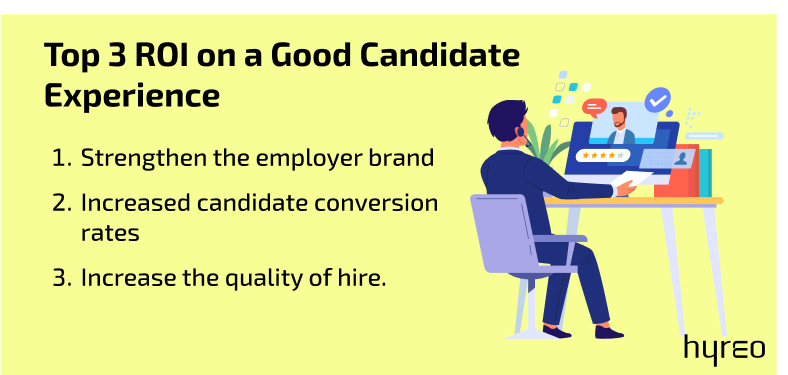The recruitment industry has witnessed a tremendous transformation from traditional ways of hiring to the current model of hiring, driven by technology. There is a shift from the traditional “Attract-Engage-Hire” mode of hiring to an “Engage-Attract-Hire” approach.
Hiring teams engage with candidates via campaigns, social media platforms, and events, showcase the brand, and attract them to the brand and then look to hire them. And in the current scenario, remote hiring and remote working have become equally critical at the workplace.
Given these changes impacting recruitment, it is inevitable for organizations to provide a channel for constant communication and create a positive recruiting experience for prospective hires.
Improved candidate experience is beneficial for the company not just to improve the overall employer brand, but also reduces cost and improves the overall quality of hire.
Here we look at what is the ROI of investing in creating a great candidate experience.
The ROI on a Good Candidate Experience

A good candidate experience can make or break the hiring process for an organization. Also, be it good or bad, the candidate experience has a direct impact on the top line and bottom line of a company. Let us look at the top four aspects of ROI of good candidate experience.
- Strengthen the employer brand
- Increased candidate conversion rates
- Lower the cost of hire
- Increase the quality of hire.
Strengthen the Employer Brand
Even when there are multiple factors that affect the employer brand, one crucial factor is definitely the candidate experience in recruiting. Though companies understand the value of employee experience, very few companies focus on implementing digital tools and processes to improve candidate experience. As per a recent research,
- 26% of candidates apply for a job based on the nature of the job role.
- 33% of candidates look for learning opportunities and work culture while applying for a job.
This means that organizations have to create more avenues for interacting with candidates to showcase who they are, the open positions, the work culture, employee benefits, and what it is to work for that brand.
And to do this at scale and with consistency, hiring teams need to look for digital platforms and tools. The reviews and experiences shared by the candidates online on third-party platforms create impressions on the pipeline and future candidates.
A point to consider here is how do organizations get positive reviews and thereby create a positive employer brand. A positive brand can help enterprises attract new talent and in many consumer industries attract new customers.
Read – 4 Ways to Create an Employer Brand
Increased candidate conversion rates
While we are analyzing the ROI of a good candidate experience, it is important for hiring teams to review candidate conversion rates. The target should be to increase candidate conversion rates. As an employer, having a low candidate conversion rate shows how inefficient the talent acquisition strategy is. So, before knowing if enterprises have a high or low candidate conversion rate, recruitment teams should know how to measure the conversion rates at each stage of recruitment.
We can measure funnel conversion rates at each recruitment stage like :
- Percentage of candidates who move from the apply to interview stage
- Percentage of candidates who move from the interview stage to the offered stage
iii. Percentage of candidates who move from the offered stage to hired stage
- Percentage of candidates who join the organization
To understand more about the calculation of conversion rates, we can take an example of an enterprise where every month, around 5000 candidates apply for job openings. Of these 5000 candidates, recruiters engage with 1000 shortlisted candidates and are interviewed for the respective roles. After the interview stages, if 100 candidates are moved to the offered stage, of which only 25 people join the organization, the candidate conversion rate can be calculated as :
Total candidate conversion rate = Number of candidates joined/Number of candidates applied *100
In our example, conversion rate = 25/5000 * 100 = 0.5%
The desired increase in the conversion rate can be brought in with an improved candidate experience strategy, where potential employees are kept engaged and informed about the process, the brand, and the job role.
Read – Top HR Trends in 2023
Lower the cost of hire
Recruiting is a painful and expensive process. Staying within the budget but producing desired results cannot be easy, especially while hiring top talent for the brand. According to a PwC survey, HR costs make up around 28% of a company’s total operating expenses on average.
With so much money at stake, recruitment teams should adopt strategies to lower the overall cost of hire. The question is how?
Recruiters should first analyze what recruitment activities take up the major portion of the budget and what can help replace those costs. Primarily, organizations look at key areas such as vendor recruitment costs, employee referral fees, and job advertising charges when calculating hiring costs.
And these costs vary depending on the role enterprises are recruiting for. Whether it is in-house recruitment or outsourced or even a mix of both approaches, there is a considerable effect on the budget that is set aside for recruitment only.
The overall cost of hire can be reduced by adopting various recruitment strategies like increasing brand advocates, using social media platforms to communicate with future employees, and using the right tools for candidate engagement and automation in recruitment.
With automation, recruiters tend to get more time to build relationships with candidates and evangelize the brand which influences the candidates’ decision to continue in the recruiting process and finally join the organizations.
Another very effective model is to ensure organizations have an effective referral scheme and in-house method of hiring, that helps hiring teams to save up a lot of the recruitment budget.
Recruiters should go beyond regular recruitment workflow management tools and adopt tools that can make recruiting more candidate-centric and bring them closer to the candidates.
Read- What is Employee Value Proposition? A Detailed Guide
Increase the Quality of Hire
The talent war has always been to attract top-quality talent. Each brand looks for A-level employees for the team. Though crucial, attracting and keeping top talent engaged is the most difficult part of recruitment.
Recruiters need to focus on different mechanisms to engage and attract A-level employees. Enterprises can source such candidates from niche communities, talent meetups, talent pools, etc, and create effective talent communities for future hiring.
The brand recall created by pushing cool stuff being done in the company, the opportunities that exist in the company, and onboarding these top talent into a smart recruiting cycle does wonders to get top talent.
Measure and improve candidate experience
Creating, executing, and improving the candidate experience strategy is critical for the employer brand and the business. All stakeholders should understand that giving candidates the ‘white-glove’ treatment, especially for the rejected ones, has a serious impact on the brand reputation, revenue, and talent pipeline.
Recruiting teams should consider the recruitment funnel as a critical part of the business and put efforts to optimize the effectiveness. Begin with measuring candidate experience in an automated way, based on different recruitment metrics like candidate conversion rate, job acceptance rate, cost, and time of hire.
Beyond the initial challenges, in the long run, the end result will be a better recruitment process, higher candidate retention, and cost savings for the organization.



